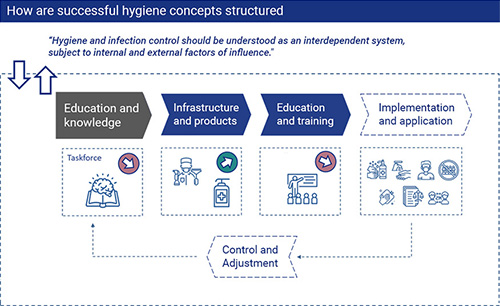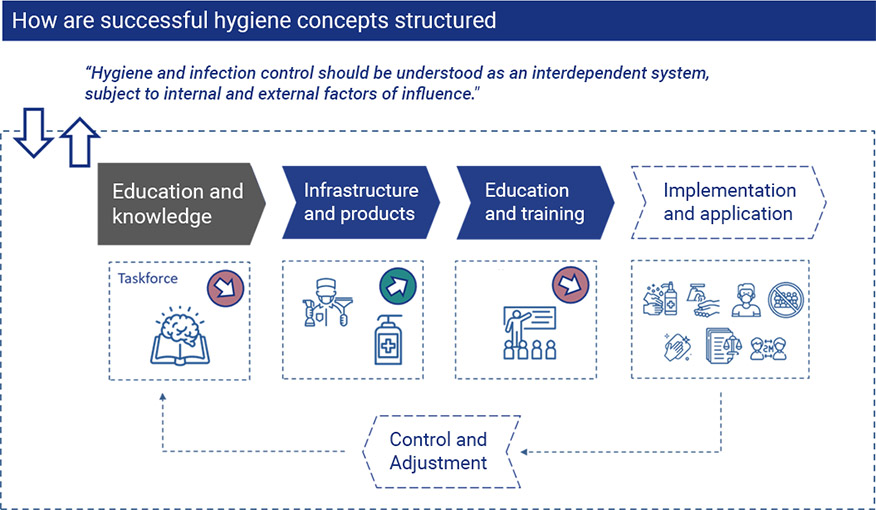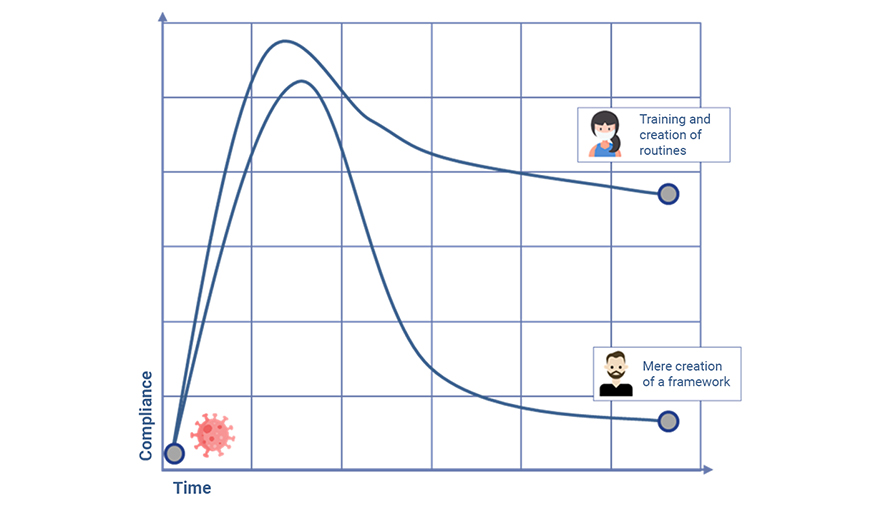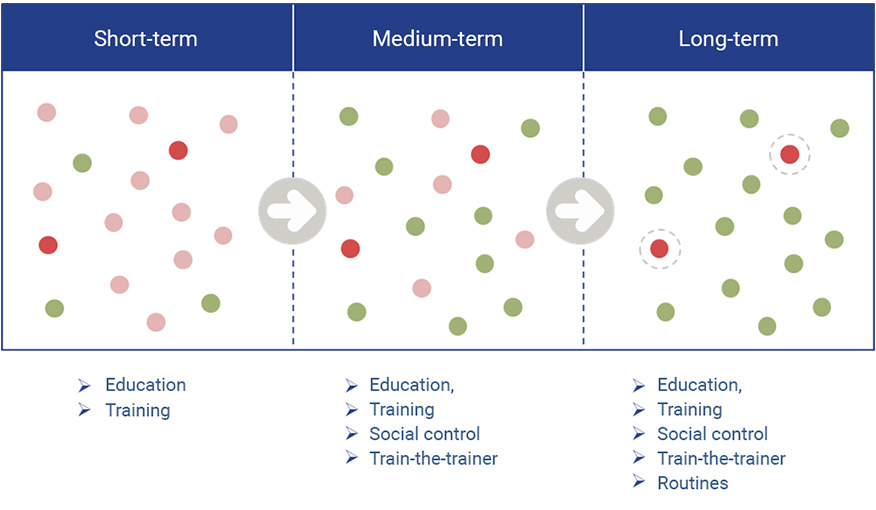
Infection Prevention in the Company - What can we learn for the future?
A critical analysis from the perspective of the hygiene industry
After more than 2 years of the Corona pandemic, it is noticeable everywhere that people, understandably, wish for normality. Things also seem to be slowly returning to normal in the professional context. Face-to-face meetings are possible again, business trips are increasing, events are taking place and trade fairs are opening. But wouldn't now be the time to ask yourself the following questions?:
- What have we learned from the last 2.5 years?
- What was useful and what was rather not?
- What can we use for future infection prevention, e.g. for the coming fall and winter season?
We at DTO Cleaning Markets have produced many studies over the last 2 years in the field of professional hygiene and infection prevention dedicated to these very topics. In this article, we want to share some of the findings with you and look at the key "learnings" for everyday operations. The fundamental question is what companies can use for the future to minimize crisis-related effects on their business. There has been an enormous learning curve, especially in the areas of digitalization and flexibilization of work. These effects are likely to remain in the long term. One reason for this is the quantifiability of the measures, for example, through a reduction in travel costs or savings in office space. If productivity remains the same or even increases, very good arguments can be found for employers to justify these measures.
In the area of operational prevention, measurability and thus the evaluation of measures is much more complicated. Studies carried out in recent months have shown that there are often no sustainably designed hygiene concepts in the companies and that the success of the prevention concepts is not measured accordingly. Instead, companies often only do what is required by law. In this context, even regular waves of illness cause a great deal of damage, such as employee absenteeism due to illness, which leads to lower productivity in the company as a whole and/or longer project lead times. However, if well-functioning hygiene concepts are considered in practice, companies could implement effective prevention concepts with simple measures. For this purpose, we would like to take a closer look at the structure and organization of hygiene concepts.
Establishment and implementation of functioning hygiene concepts in companies
Basically, hygiene and infection control concepts are interdependent systems that are influenced by internal and external factors. They consist of three essential elements that must be coordinated with each other. With regard to companies, it is first of all enormously important that the management level is convinced of the topic and supports it accordingly. In addition, the latter has a role model function which, with a corresponding commitment, leads to higher compliance in the observance of hygiene measures in the entire company or the corresponding departments.

Fig.1: Structure of successful hygiene concepts - Own illustration based on World Health Organization (2009): a Guide to the Implementation of the WHO Multimodal Hand Hygiene Improvement Strategy.
The framework and strategy for the hygiene and infection control concept should also be planned at management level. This is often done with the help of external support, e.g., a hygiene consultant from a facility service provider or partner operating in the company. Once the framework has been planned, the next step is to create an appropriate hygiene infrastructure. This includes the provision of hygiene products (e.g., soap and paper towels in the washrooms or the installation of disinfectant dispensers) and the corresponding visual communication (e.g., by means of information signs or posters). It is important to note that the hygiene products should be placed in such a way that they can be reached and seen as easily and quickly as possible. If, for example, users have to spend time searching for washrooms or dispensers, compliance is reduced.

Fig.2: Comparison - compliance development with and without training measures.
The third module deals with the users. A key lesson learned from the Corona pandemic is that the successful implementation of hygiene concepts depends to a large extent on the involvement of the users. They must be trained and sensitized accordingly in order to maintain a high level of compliance over the long term. It is not only a question of applying hygiene measures, but also of why, how and when. Up to now, hygiene and infection prevention have not been an integral part of school and vocational training. Consequently, there is a lack of knowledge, e.g. in microbiological basics, and a lack of routines. This makes it extremely difficult to adapt hygiene concepts ad hoc to changes in the environment. However, if the users are familiar with the hygiene basics, concepts can be easily and successfully adapted to the respective situation (e.g. the annual flu epidemic). This also has other effects. For example, systematic education and regular training of users increases the proportion of those who adhere to hygiene measures and pass on their knowledge. This leads to train-the-trainer effects and, in the long term, to the formation of routines. As shown in the diagram, not all users need to be reached to the same extent. What must be considered, however, are social effects. Despite training and education, people behave differently toward those they know and like than toward strangers.

Fig.3: Evolution in the creation of routines.
The last aspects to be mentioned are control and adaptation. In order to implement hygiene concepts successfully in the long term, it is necessary to establish a control mechanism and make the necessary adjustments. This can be done, for example, through selective compliance measurements or a determination of product usage and consumption.
What does this mean for business decision makers and what should they consider in terms of future pandemics and regular waves of illness, e.g., in the fall/winter?
Basically, it can be said that the importance of prevention concepts is viewed very differently in the companies. This applies both to health prevention in general and to hygiene and infection control concepts in particular. The number of employees absent due to illness could be minimized through better health education and simple hygiene concepts. If the costs of prevention measures are compared with the damage caused by employee absences, e.g., due to longer project lead times or additional personnel recruitment measures, it quickly becomes clear that hygiene and infection prevention concepts should not be viewed primarily as cost items. The conception and implementation costs are comparatively very low. Moreover, learning effects can be achieved for future disease outbreaks. With regard to the fall/winter season, now is the right time to deal with this topic. Since it is foreseeable that we will have to deal with more waves of illness again in winter, existing hygiene concepts should be put to the test.
Text written by Michael Di Figlia